My last five days at Outlaw have officially come and gone. This has been an amazing experience for me, and I opened more doors with it than I realized were possible when I first started. I have been offered a guaranteed, paying job next summer with Outlaw if I wish to take it and I can confidently say I will most likely be accepting, at least for a few weeks. I hope to continue to build my relationship with them and see where that journey may lead me.
This past week, I took care of the ICU treatments and helped teach the new technicians about the different medicines and procedures used during the day. Along with the new techs, new horses were constantly flowing in and out of the barns, so I stayed busy trying to keep up with the changing medications and schedules, which meant I was administering several different injections, the most prevalent being Banamine. Banamine injections help relieve fevers, swelling, and other types of pain in sick horses. However, it can be lethal if not used correctly. This drug can only be given through a horse’s catheter, not the muscle. If injected through the muscle, Banamine can slowly tear the skin from the muscle and cause it to shred, which will inevitably kill the horse. Penicillin is another, potentially fatal injection. It must be given at a rate of 1cc every 5-10 seconds. Doing it any faster will cause the medicine to race to the heart, making the horse drop dead within seconds. There are some warning signs to look for, however, to help prevent this outcome like drool pouring out of the mouth, shaking, or uncontrollable urination. I have to say it was nerve-racking the first time I handled and gave Penicillin to a horse.
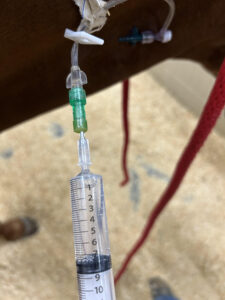
This is what a Banamine injection looks like. As shown, it is only going through the catheter. Banamine also reacts with almost everything, so the catheter has to be flushed very well before and after the injection to prevent any nasty outcomes from occurring.
There was a horse this week in ICU that had a disk placed in his trachea. This was allowing his sickly airway to clear up more effectively, although it was very startling to come across at first because I could hear his breath moving up and down his trachea, and if he tried to whinny, it only came out as a slight wheeze. This poor horse could not make a sound.
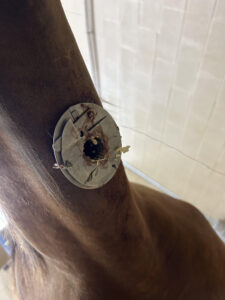
Here is the trachea disk. We had to clean it well with baby wipes every day to make sure nothing was covering or going into the hole in the middle. If there was, that could easily cut off his airway and suffocate him.
We were also tending to the sweetest laceration baby this week. A laceration case is when there are many deep cuts or bruises on the body of a horse. This particular foal was tangled up in some fence and had many nasty cuts all over his chest, shoulders, legs, and face, many of which had staples put in. This accident also caused the colt’s left eye to be scratched, which meant eye drops had to be put in every night to help it heal.
- Here you can see the cuts on his shoulder, legs, and nose.
- These are the staples that were put into his face. He has several patches of these across his body.
Many horses need to be cold lasered due to their wounds. Cold lasering is when a small, handheld device is hovered over the wound to help speed up skin regrowth. They usually take 5-10 minutes to complete.
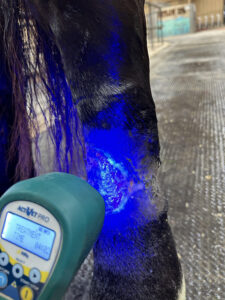
This is the process of cold lasering. This horse actually ended up being euthanized because her hoof was starting to peel from the bottom, which could have led to her entire foot coming off the leg.
That wraps up my last week at Outlaw Equine. I received many hugs before I left today, even one from the head doctor, and I can truly come away from this experience knowing I have proved myself and my work ethic to their team. I am very pleased with how my internship ended and am proud of the future opportunities I have potentially created for myself.

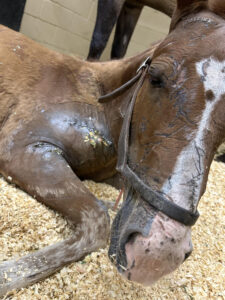
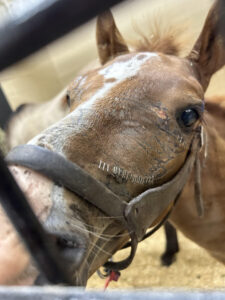
There are no comments published yet.